
| Home | About Us | Contribute | Bookstore | Advertising | Subscribe for Free NOW! |
| News Archive | Features | Events | Recruitment | Directory |
| FREE subscription |
| Subscribe for free to receive each issue of Semiconductor Today magazine and weekly news brief. |
News
27 December 2006
Common platform for 10Gb/s transceiver development to cut design cycle time and costs
Apogee Photonics of Allentown, PA, USA is shipping samples of a single-platform approach, based on its 1310 and 1550nm telecom laser sources, for creating pluggable 10Gb/s transceivers for a wide range of optical network applications, cutting development and qualification design cycles and speeding time to market.
Multi-source agreements (MSAs) for 10Gb/s transceivers are well established; there is a proliferation, from the first-generation 300-pin MSA and the XENPAK MSA (for datacoms) to the next-generation XPAK/X2 MSAs (for datacoms) and XFP (the first pluggable MSA that could handle telecoms, datacoms and Fiber Channel). “The definition of new transceiver MSAs such as SFP+ [which is smaller and cheaper than XFP] requires many of our customers to make hard trade-offs in the number of transceiver products offered, given engineering resource constraints,” says Scott Keller, VP of sales and marketing. The six MSAs form-factors, and the six different distance reaches specified (SR1, IR1, IR2, ER, LR, LR2) for each, requires a multitude of components to be designed-in and stocked by module makers and original equipment manufacturers.
The combined 1310/1550nm architecture allows module and original equipment manufacturers to adopt a standardized single platform serving the multiple 10Gb/s transceiver interfaces with a single XFP-type board and case. Transceiver-level design choices related to receptacles, flex guides, output pinning and driving only need to be made once. Apogee claims that the platform reduces the risks associated with new transceiver introductions and provides development cost savings, decreasing the separate qualification cycles of each new product.
The 1310 and 1550nm 10Gb/s sources are both externally modulated lasers (EMLs, i.e. a continuous-wave distributed feedback laser with an electro-absorption modulator) and are mechanically and pin compatible (e.g. the 10T3005 1310nm uncooled TOSA for LR and SR1 has a receptacle and flex guide compatible with the TLA10X 1550nm cooled XMD TOSA for ER, IR2 and LR2). To enable this, Apogee had to modify the 1310nm form factor to match the 1550nm source (involving re-designing the wiring, for example).
To support this single-platform approach, Apogee has a T10-0120-021 evaluation board using the Vitesse VSC7982 driver that supports both the 1310 and 1550nm TOSA. Similarly, an evaluation board (T10-0120-022) is available using the OKI 4195 driver.
Apogee’s approach allows customers to broaden their product range while reducing the cost, materials and resources involved in the design and qualification of separate platforms, claims Keller.

Apogee’s single-platform 1310nm uncooled EML TOSA (left) and 1550nm cooled TOSA EML (below) lasers.

See related item:
Apogee to introduce uncooled 20Gb/s and 25Gb/s 1310nm CWDM lasers for emerging 100GbE optical standards
Visit:
http://www.apogeephotonics.com